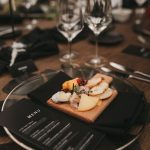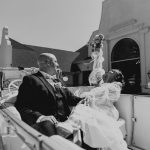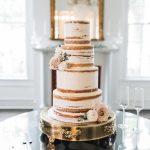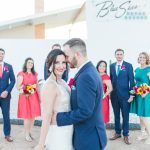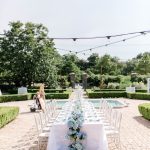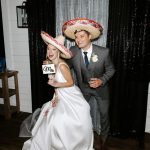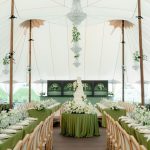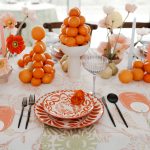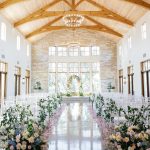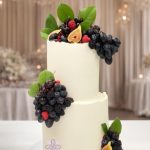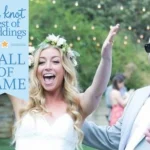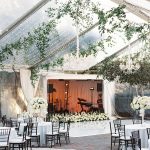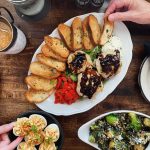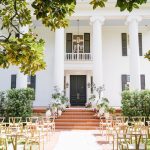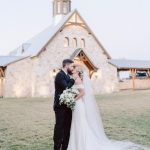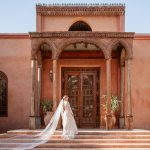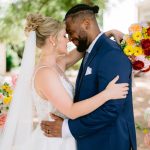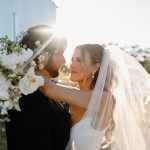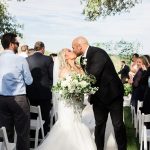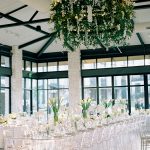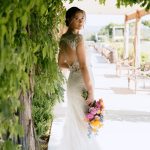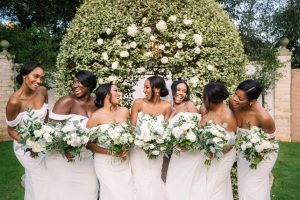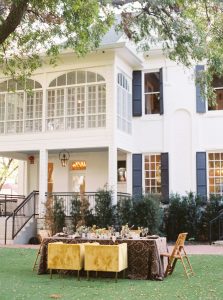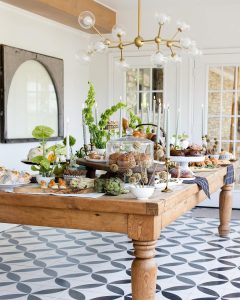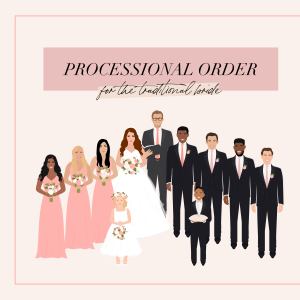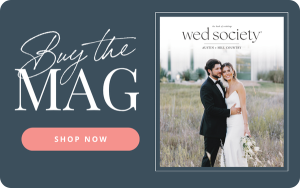Now that you’re engaged, it’s time to start meeting with planners, florists, venue coordinators, and more. It’s a great idea to learn a bit of the lingo before you get started, so we’ve created a list of wedding planning terminology to help you feel confident when you walk into your next wedding planning meeting. Here’s a quick guide to all the words you need to know to help you eat, drink, and be married!
Photo: Nikk Nguyen Photo
ENGAGEMENT
Engagement Photos — These are used as a way to document the couple’s engagement and are often personalized in a way that showcases the couple’s love story. This is also commonly used to get comfortable working with your wedding photographer.
Fiancé — The person to whom you are engaged. This can also refer to a man who is engaged to be married, which takes from the French version of this term.
Fiancée — A woman who is engaged to be married.
It’s important to note that American English doesn’t have gendered word endings, but if you see these terms this is what they can mean.
Wedding Hashtag — Personalized wedding hashtags are used so that guests can follow updates from the wedding as well as post their own photos and well-wishes from the event on social media in a way that the couple can easily find it. There are services that will help you generate wedding hashtags.
Wedding Registry — A service offered by a store or organization where a couple lists their gift preferences for their family and friends to use. Couples typically choose 2-4 places to register for wedding gifts. This term can also be listed as Bridal Registry and Gift Registry.
Wedding Website — A personal wedding website is a website that engaged couples use to communicate with guests for their wedding. These can range from free services to highly customized designs for a fee. Couples use these to tell their love story, share wedding details, gift registry information, and more.
WEDDING PLANNING
Design
Mood Board — Your mood board is something that helps you visually communicate your wedding inspiration and desired style. This can include images with certain colors or textures as well as physical items that you are inspired by. Your planner will often create a mood board with you. However, you can create your own and use it in your meetings with your vendor team.
Palette — This refers to the range of colors you plan to use at your wedding. You may get asked, “what is your color palette?” While you may have a single color in mind, you’ll want to have a range of colors that work well together. Your wedding planner or primary vendor can help you create this.
Logistics
Run Sheet (or Runsheet) — This is a document that lists all the action steps in the wedding planning process or specifically in the day-of process. This is something your planner or primary vendor, such as a day-of coordinator, will want to create together.
Shot List — This refers to the list of desired photos you would like the photographer or videographer to capture at your wedding events. You will want to think through what types of images are most important to you.
Full Planning — This refers to wedding planning and coordination packages for couples who want a full-time professional to oversee every aspect of their wedding planning and wedding day. This includes things such as vendor management, scheduling, marriage license, tracking RSVPs, creating the planning timeline, and overseeing the big day itself, etc.
Partial Planning — This typically involves month-of wedding coordination along with some additional planning services with a set number of hours dedicated to the client. This can be helpful for couples who want to be very hands-on but need professional coordination as the day gets closer.
Wedding Coordinator — While most Wedding Planners offer coordination services, a wedding coordinator maintains contact with vendors and serves as a liaison for the couple. Many wedding coordinators offer month-of, week-of, and day-of services.
Rain Plan — A rain plan is just what it sounds like. It is the backup plan in case of rain and inclement weather.
Room Flip — This refers to when a room is completely transformed between the stages of a wedding or event. The most common room flip example is having your guests leave the ceremony for a cocktail hour only to come back to the same room for the reception. This is done to help economize for space and budget as well as to limit the inconvenience of needing multiple locations.
Venue Walkthrough — A venue walkthrough is an appointment to see a potential wedding venue, ask questions, take pictures, and ultimately envision what your event would look like there. All wedding venues encourage couples to schedule an appointment for a personalized venue walkthrough.
Venue Coordinator — This is the person at the venue that will book your wedding, help with services such as menu and floral that are in-house services and make sure the event runs smoothly during your reception.
Vendor Meal — This refers to the additional meals you may need to arrange for the vendors that will be working at the event itself.
In-House — This is the term used when additional services are offered by the vendor. Most commonly this is used in relation to venues. They often offer in-house catering or floral arrangements services and event planning in some cases.
Golden Hour — This is a photographer term referring to a pre-sunset time when the natural light is ideal for taking wedding photos. The event time will play into when your wedding photos should be taken.
Hard-Stop — The time at which your wedding festivities have to be over by and guests need to be off the premises.
Wedding Type
Destination Wedding — This refers to a wedding that takes place in a different state, or country than the couple lives and often has the wedding party or guests staying with the couple for a weekend or more in that location.
Elopement — While the term used to indicate running away to get married, now the term is most commonly used to indicate a purposefully small or paired down event. This could range from only the couple being in attendance to a few friends and family.
Intimate Wedding — An intimate wedding typically has fewer than 75 guests. This style of wedding is purposefully low-key, though that doesn’t have to mean casual.
Micro Wedding — A micro wedding is a wedding or reception with less than 50 guests. One version of a micro wedding is to combine an elopement with a small reception.
Dress Code
Black Tie — This dress code is for events starting after 6 p.m. and is traditionally the most formal dress code.
Black Tie Optional — This dress code indicates that men do not have to wear a tuxedo and women have the option to wear a range from full-length gowns to cocktail dresses.
For more information on dress codes, check out our blog post — What Does This Dress Code Mean?
Wedding Attire
Tuxedo — This specifically refers to a man’s dinner jacket and comes in a range of styles from the traditional to the more modern as well as different colors.
Waistcoat — This is the vest typically worn by men over a shirt and under a jacket.
Cumberbund — This is the broad waistband worn in place of a vest typically in men’s clothes.
Cufflinks — The device for fastening two sides of a shirt cuff together. These also make great wedding gifts to your fiancé
Appliqué — Appliqué is the ornamental needlework and detailing often seen on wedding dresses. This ranges from glitter and beads to extensive lace.
Grosgrain Ribbon — This is a ribbed fabric that comes most often in belts, sashes, and even floral bouquets.
Wedding Veil — The wedding veil is worn on the head and comes in a wide variety of styles. From the floor-length cathedral veils to blusher veils that cover the bride’s face, you can find these in lace brocade, tulle, organza, silk, and chiffon fabrics.
Silhouette — In the context of weddings, this refers to the shape of various wedding dress styles. Experts will refer to the different styles by their silhouette name most often. These include ballgown, fit-and-flare, mermaid, and more.
Godets — This is the name for the triangular piece of material inserted into a dress to make it flared for a more dramatic or ornamental look.
Wedding Party
Officiant (or Celebrant) — This is the person that officiates at the wedding ceremony. This can be a religious figure, a civil celebrant, or an ordained friend or family member.
Best Man — Considered the principal groomsman. Often the role is filled by the most important person to the groom.
Groomsman — These are members of the groom’s party and officially attend to the groom at a wedding.
Ring Bearer — This is a carryover from a more traditional style wedding and the role was typically filled by a young boy who carried a ring tied to a pillow down the aisle. Today, traditionally, the best man keeps the rings with him until the groom needs them. This role is often filled by the couple’s pets or young relatives.
Maid of Honor — This is the title for an unmarried woman acting as the principal bridesmaid at a wedding. This role is typically filled by a sister or best friend of the bride.
Matron of Honor — Similar to the bridesmaid, this role is given to the married woman acting as a principal bridesmaid. Some brides have both a maid and matron of honor while some opt for one or the other.
Bridesmaid — These are members of the bride’s party and are typically close friends or family members of the bride.
Flower Girl — The flower girl is traditionally filled by a young girl that walks down the aisle just ahead of the maid of honor, after the bridesmaids. She scatters flower petals along the aisle before the bride. This role has changed in recent years to include grandmothers and male friends or relatives who act as flower attendants.
Attendants — This is anyone that plays a role in the wedding including the best man, bridesmaids, ushers, flower girls, etc. These people are called this because they have roles and responsibilities to “attend” to during the wedding.
Usher — An usher is typically a male relative or friend of the couple that shows guests to their seats for the ceremony as well as answer general questions.
Guests
Guest List — The list of people invited to your wedding.
Seating Plan (or Chart) — The seating arrangement selected for your guests to use during your wedding reception.
Plus One — This is a term referring to your wedding invitation by giving an invited guest the opportunity to bring someone of their choosing.
Welcome Bag — Welcome bags are typically gifts given to out-of-town guests including family and friends that have come from a distance to attend your wedding. These gifts are usually prepared and delivered to hotel rooms or guesthouses and filled with convenience items or local delicacies.
Room Block — This refers to the practice of blocking off 10+ rooms at a hotel or hotels for out-of-town guests. These often come with a slight discount and are especially helpful for guests to locate a convenient place to stay while they are in town for the wedding.
Details
Save-The-Date — This is something that is sent to guests ahead of the invitation in order to allow them to save the wedding date on their calendar.
Invitation Suite — An invitation suite refers to all the various pieces that come with a wedding invitation including the wedding invitation, response card, information card, and often includes wedding stationery.
Wedding Stationery — This is separate from the wedding invitation, though often part of invitation suites. It is a personalized stationery that is used for thank you cards and more.
Letterpress — This is a vintage-style printing with a deep impression. This is the opposite of embossing, which produces a raised image.
Vellum — Vellum is a type of paper that is see-through and often used in highly-stylized wedding invitation suites.
Escort Card — Escort cards direct guests to a table vs. a specific seat. These are considered a less formal choice than place cards.
Place Card — Place cards show guests both a table and the specific seat they have been assigned. Traditionally, this means the reception is a more formal event with a served dinner option.
Wedding Program — Traditionally, this refers to the piece of paper that lists the order of events in your celebration including who is participating in each phase of the event. This allows guests to know who is doing any readings or the names of your wedding attendants and more.
Flowers
Boutonnière (or Boutineer) — This is a single flower or small bud that is worn, typically by a man, in the buttonhole of his lapel.
Corsage — A small bouquet of flowers worn, typically by a woman, on her dress or around the wrist. At weddings, these are often worn by the mothers of the bride and groom as well as grandmothers and other females that play a prominent role in the events of the day.
Bouquet — This is often referring to the bridal bouquet, which is the flower arrangement carried by the bride as she walks down the aisle. The maid of honor holds this for her during the ceremony and returns it for the recessional.
Nosegay — This refers to a small bunch of flowers that are often particularly sweetly-scented. Other terms for this type of bouquet are posy and tussie-mussie.
Garland — This is a band or chain of flowers, leaves, or other types of foliage. This can refer also to wreaths worn on the head, but typically this refers to the festive florals draped in loops throughout the event space or as runners on tables.
Pomander — As it relates to weddings, a pomander is typically a decorative ball of flowers used in wedding decor.
Flower Wall — This can be a full wall of florals or can refer to single flowers or garlands draped in single strands as a backdrop.
Cake
Buttercream — This is a popular icing for wedding cakes. The most common types of buttercream are American, Swiss Meringue, and Italian Meringue.
Fondant — Fondant is associated with more luxurious cakes and is most often used to sculpt or decorate cakes. It’s a unique consistency and is a popular alternative to the buttercream.
Ganache — This is another popular way to “ice” a cake as well as a cake filling. It is a mixture of chocolate and cream and has a firm consistency.
Royal Icing — Royal Icing is a mixture of powdered sugar, water, and meringue powder. This is most often used to hold decorations together and in piping.
Naked Cake — This is easily identifiable because it has minimal or no outer layer of frosting to show off the cake’s texture and filling. This trend has been around for a while now and has only gained in popularity.
Cutting Cake — This is the cake that gets cut in the traditional ceremony for the photo opportunity, but is not typically enough to serve all the guests at the wedding. This is also a more expensive cake.
Sheet Cake — This is the cake that is a less expensive option and is slightly different from your cutting cake typically. This is most often cut in the kitchen and served to guests as single slices.
Decor
Centerpiece — These are decorative pieces for display in the middle of a dining or serving table.
Tablescape — This is a term for the artistic arrangement of decor and flowers on any given table.
Charger — This is a large decorative base setting that the dinnerware is placed on during formal dinners.
Place Setting — This is a complete set of dishes and cutlery provided for a single guest at the reception — or during a meal.
Candelabra — This is a large, branched candle holder that can be placed on tabletops or large candelabras can be used in altar decorations and more.
Taper Candle — A taper candle is one that narrows slightly from a wider base to a “tapered” top. They fit most standard candle holders and have a traditional burn time of one hour per inch.
Tealight Candle — These are tiny candles in a thin metal or sometimes plastic cup. They are an inexpensive and attractive candle option.
Gobos Lighting — Gobo stands for go-between optics. Gobos lighting comes from a stenciled circular disc used inside a lighting fixture. These can be customized with patterns, initials, names, and more.
PARTIES, SHOWERS & EVENTS
Engagement Party — An event hosted by the friends or family of a couple to celebrate their engagement.
Bachelor and Bachelorette Party — These are respectively the groom (bachelor) and bride’s (bachelorette) celebration with their wedding party. These can also include a wider group of friends and be an entire getaway vs. a single night party. They do not have to be scheduled on the same night and don’t have to take place on the night before the wedding.
Rehearsal Dinner — This includes the wedding party as well as some extended family or close friends and takes place after the wedding rehearsal the day before the ceremony. This can also be Rehearsal Brunch or anything your specific schedule needs it to be.
GETTING READY
First Look — A first look is when the bride and groom have a private moment to see each other before the ceremony. This is often captured on film by the photographer and videographer. First looks can also be done with other members of the couple’s friends or family.
First Touch — Some couples prefer not to see each other before the ceremony, but would still love to have a private moment alone. A first touch is when the couple is separated by a wall or door and hold hands for a moment.
THE CEREMONY
Prelude — This is the music that is played while guests are being seated for the ceremony. It can be whatever the couple prefers.
Wedding Processional — This refers to the wedding party walking down the aisle. This includes the officiant, parents, bridesmaids, flower girl, ring bearer, bride, and groom.
Vows — Vows are the promises partners make to each other during the wedding ceremony. Many couples opt for writing their own vows either in addition to or instead of the traditional options. Depending on the culture and/or religious background of the couple, vow types can vary greatly.
Recessional — This is when the wedding party exits after the ceremony.
THE CELEBRATION
Food and Drink
Cocktail Hour — The hour after the ceremony and before the reception where guests mingle and are served drinks as well as food such as hors d’oeuvres. This doesn’t always have to be an hour.
Corkage Fee — This is the fee charged per bottle, specifically when you have provided your own wine or alcohol. You will want to speak with your caterer about their corkage fee policy when negotiating your contract.
Open Bar — At an open bar option the drinks have been paid for by the host.
Signature Cocktail — This can be one drink or in some cases, two drinks from the bride and groom served as a particular treat for the event. Couples often pull from their love story, family history, and more to create a special drink for their wedding day.
Feasting Style— This style of catering usually features a variety of food options where guests can serve themselves. In feasting style, there is a particular focus on beauty and delightful tastes. In some cases, this looks like a luxurious charcuterie set up.
Plated Sit-Down Dinner — This style of catering is usually predetermined with options listed on the reply card of the wedding invitation. Guests are served their meal by the wait staff.
Canapé — A small piece of bread or pastry with a savory topping served with drinks.
Crudite — These are traditional french appetizers featuring sliced or whole raw vegetables with dipping sauces.
Reception Details
Grand Entrance — This is when the newlyweds are introduced at the reception.
Head Table — This is the principal table at the wedding reception where the wedding party traditionally sits. In some cases, the newlyweds sit with the group at the head table. In other cases, they have their own private sweetheart table.
Sweetheart Table — A private table set up just for the newlywed couple.
Send-Off — This is when the couple makes their official exit from the reception. Traditionally, this is where the couple leaves for their honeymoon, but many modern couples opt for a different timeline. The send-off is where the couple walks through the guests who have lined up to cheer them out. Guests can cheer with bubbles, streamers, flowers, flags, and more. Many people also make their exit to fireworks.
WEDDING PLANNING TERMINOLOGY
These are just some of the most common wedding planning terminology that you need to know.
Here are a few quick recommendations for learning the rest of what you need to know —
- Get comfortable asking questions. Whether it’s contract or pricing negotiations or wondering what the difference is between family-style and feasting-style is, it’s important to be comfortable asking vendors to explain the details. If you’re not clear on something, don’t be embarrassed to ask for clarification. Vendors are usually happy to explain.
- Do your research. Our blog has tons of helpful guides to help newly engaged folks just like yourself. Plus, there are many helpful resources online. Rely on your vendors for their guidance, but make sure you are staying up-to-date with the information.
- Don’t assume anything. It can be easy to assume you and a vendor are on the same page but don’t do it. Don’t assume something is included in the contract because it seems like it would be or vice versa.
HAPPY WEDDING PLANNING
Now that you know all this wedding planning terminology, it’s time to put it to use!
If you’re still looking for the perfect local wedding vendors for your wedding — you’ve come to the right place. From photographers to wedding planners, calligraphers, and more, we’re here to help you simplify your search. Click here to get started.


